Did you know there are many ways to extract CBD from hemp? CBD products are getting more popular. So, it’s key to know about different extraction methods. In this article, we’ll look at supercritical CO2 extraction and ethanol extraction. We’ll also cover other methods. This guide is great whether you love CBD or are just learning about it. It will help you understand more about CBD extraction.
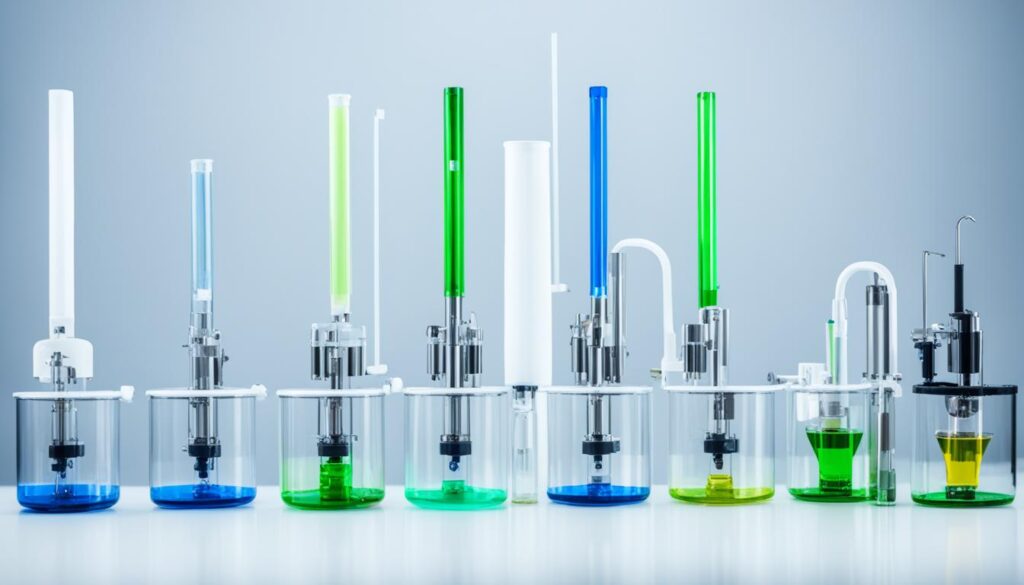
Key Takeaways:
- Supercritical CO2 extraction and ethanol extraction are two popular methods used to extract CBD from hemp biomass.
- CO2 extraction is known for producing high-quality, pure, and consistent oils, while ethanol extraction preserves the full spectrum of beneficial compounds found in hemp.
- Other techniques such as oil extraction, steam distillation, and dry ice extraction are also used for CBD extraction.
- When choosing an extraction method, factors such as cannabinoid recovery, solvent recovery, safety, organic certification, scalability, and operating costs should be considered.
- Understanding CBD extraction methods is crucial for ensuring the safety, quality, and efficacy of CBD products.
Comparison of Solvent and CO2 Extraction Techniques
In the CBD world, two main methods stand out for extracting CBD. These are solvent extraction and CO2 extraction. Each has its pros and cons. It’s key to know these differences to pick the best method for making CBD.
Solvent Extraction
Ethanol extraction is a common choice in the CBD industry. Ethanol helps pull cannabinoids from hemp. It’s cheaper than some other methods. But, it’s not without its issues.
- **Ethanol extraction needs organic ethanol** to avoid contamination. This raises the process’s price.
- **Removing chlorophyll** is needed for a clear, high-quality extract. This means more steps are added.
- The **cannabinoid recovery rate** with ethanol is between 50% and 80%. This shows efficiency isn’t perfect.
- **Handling ethanol waste** is a challenge. It’s hazardous until completely removed. Proper waste management is a must.
CO2 Extraction
Supercritical CO2 extraction is highly regarded. It’s because it makes top-notch CBD oils. This method uses carbon dioxide under special conditions.
- **Better cannabinoid recovery** is a big plus of CO2 extraction, with rates of 85% to 95%. This means more CBD is extracted from the hemp.
- **CO2 is safe** and okayed for organic use. It’s risk-free for both people and our planet.
- **It requires less infrastructure**. So, it’s simpler than other extraction options.
- But, CO2 extraction **costs more**. The equipment and operation expenses are higher. It requires a significant initial investment.
Each method, solvent and CO2 extraction, has its good and bad points. Your choice depends on factors like cost, safety, and how much CBD you want to make.
Having looked at solvent and CO2 extractions, we’ll now explore more about the benefits and drawbacks of CO2 extraction.
| Extraction Technique | Pros | Cons |
|---|---|---|
| Solvent Extraction | – Lower cost – Easy to get ethanol – Works for small batches |
– Needs organic ethanol – Removing chlorophyll – Not all CBD is extracted |
| CO2 Extraction | – Gets more CBD – Safe, organic solvent – Less equipment needed |
– Costs more for gear and to run – Big initial investment |
Pros and Cons of Supercritical CO2 Extraction
Supercritical CO2 extraction is known as the top choice in the CBD industry. It offers many benefits but also some negatives. Knowing the good and bad about this method helps make smart choices in CBD production.
Benefits of CO2 Extraction
- High Cannabinoid Recovery: Supercritical CO2 extraction has a high recovery rate of 85-95%. This means it’s very efficient and produces a lot.
- Recyclable Solvent: CO2 can be used again in this method. This cuts down on waste and costs because you don’t need to get rid of the solvent.
- Organic Oils: The CO2 method makes organic CBD oils. This gives users a clean and natural product.
- Safety: This method is safer than others. It doesn’t have fire hazards and needs less equipment.
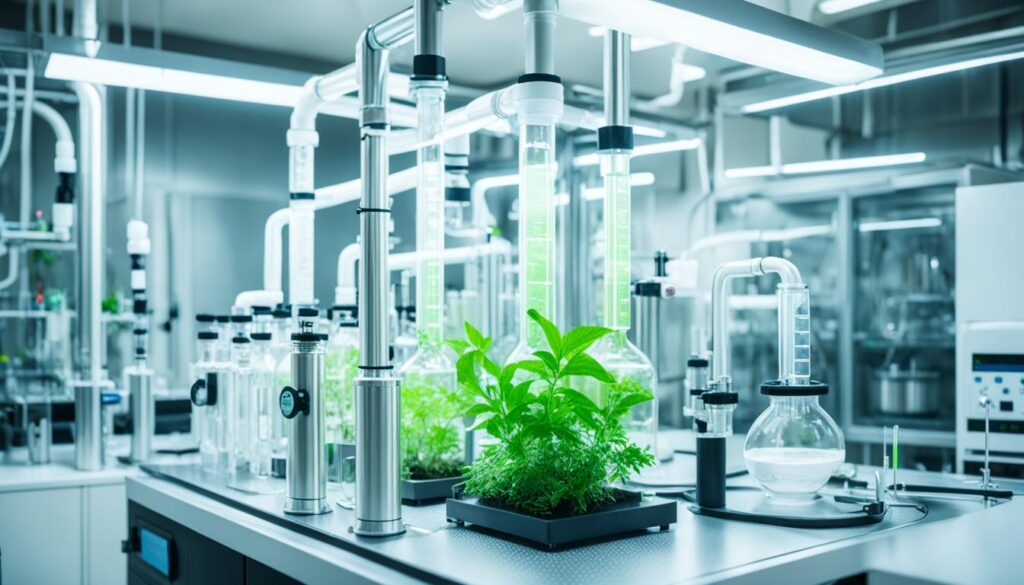
Drawbacks of CO2 Extraction
- Equipment and Operating Costs: The setup for CO2 extraction is pricey. It requires a big investment from CBD producers in terms of both equipment and running costs.
- Loss of Delicate Constituents: CO2 extraction can remove some of the delicate parts of hemp. This might mean losing some aromatic terpenes and other good compounds.
While supercritical CO2 extraction has many pluses, it’s important to think about the costs and possible loss of delicate parts. This will help in choosing the best extraction method for CBD production.
Pros and Cons of Ethanol Extraction
Ethanol extraction is often chosen for hemp processing. It does a great job at preserving all the helpful compounds. This method captures 50-80% of cannabinoids. It can also pull out organic oils effectively.
Plus, ethanol avoids cross-contamination, making it a safe choice. It’s a natural choice and good for our planet too.
“Ethanol extraction allows for the extraction of organic oils without the risk of cross-contamination.”
Yet, ethanol extraction isn’t perfect. It tends to be pricier than CO2 methods, especially in terms of energy, testing, and swapping solvents. Another issue is it might draw in chlorophyll. This can change how the final product tastes.
Advantages of Ethanol Extraction:
- Typical cannabinoid recovery of 50-80%
- Ability to extract organic oils
- No risk of cross-contamination
- Natural solvent and environmentally friendly
Disadvantages of Ethanol Extraction:
- Higher operating costs compared to CO2 extraction
- Potential taste alteration due to chlorophyll absorption
| Pros of Ethanol Extraction | Cons of Ethanol Extraction |
|---|---|
| Typical cannabinoid recovery of 50-80% | Higher operating costs compared to CO2 extraction |
| Ability to extract organic oils | Potential taste alteration due to chlorophyll absorption |
| No risk of cross-contamination | |
| Natural solvent and environmentally friendly |
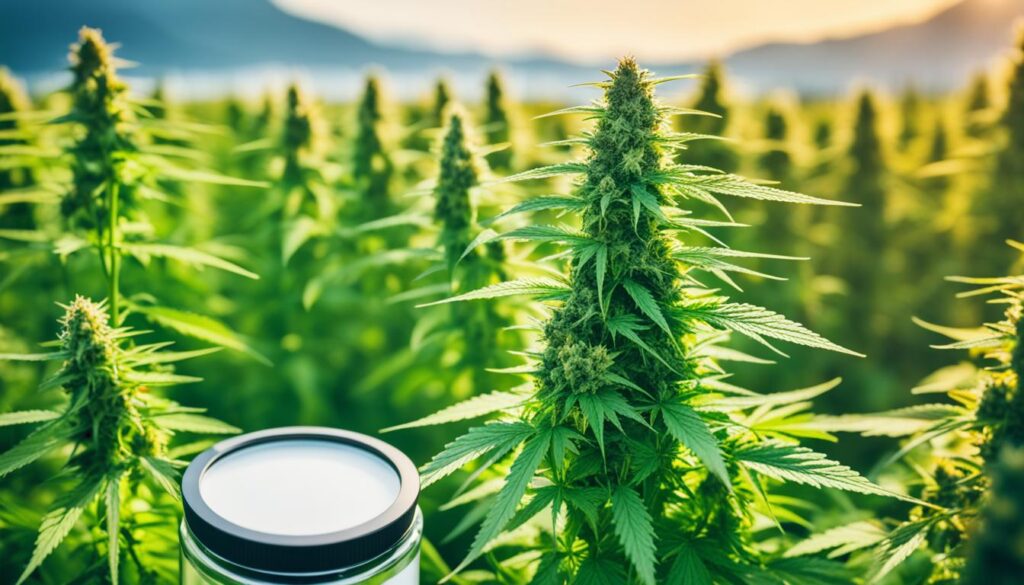
Other CBD Extraction Techniques
CO2 and ethanol extraction are common in the CBD industry. But there are other methods too. These alternatives have their own benefits and things to consider for CBD extraction from hemp.
- Oil Extraction: A popular method for home enthusiasts is oil extraction. This involves soaking hemp in oils like olive or coconut. But, the strength of the extracts might not match other methods.
- Steam Distillation: Steam distillation uses steam to get essential oils from hemp. It’s safe and pure but needs more hemp for the same amount of extract.
- Dry Ice Extraction: Using dry ice, this method freezes and separates trichomes from hemp. It’s less common for CBD but notable for THC products. It offers a unique approach to extraction.
Different extraction methods have their pros and cons. It’s important to think about potency, consistency, and how easily the method can be scaled up. While CO2 and ethanol are popular, exploring other methods can open new possibilities.
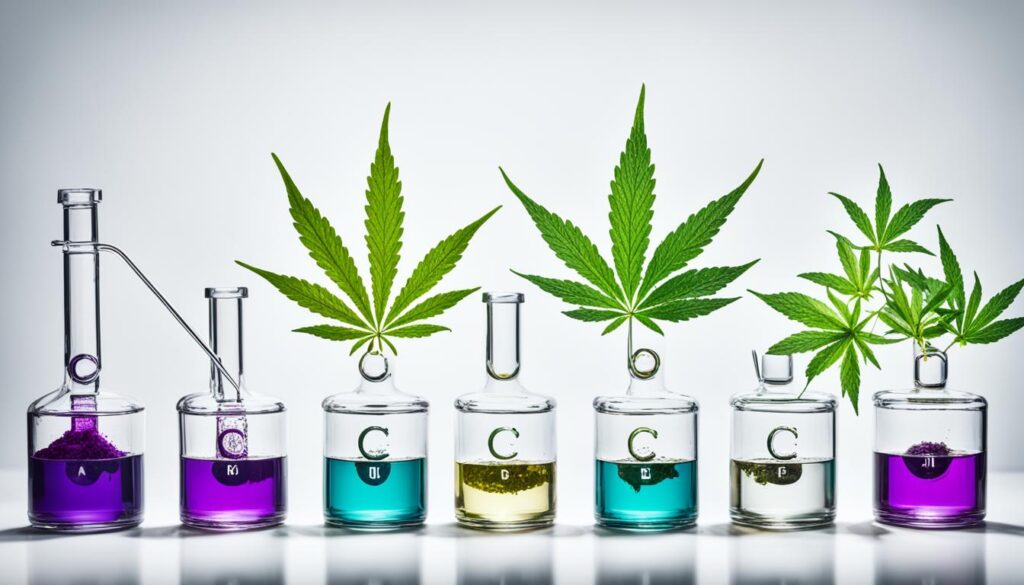
Factors to Consider When Choosing an Extraction Method
Choosing the right extraction method for CBD production is key. There are many factors to think about to ensure safety, efficiency, and quality. These factors are critical for the best CBD extract outcome.
Factors Affecting CBD Extraction
1. Cannabinoid Recovery: The efficiency of the extraction method is vital. It should recover the desired cannabinoids well from the hemp. This means a more potent and effective CBD extract.
2. Solvent Recovery: Some methods use solvents, like CO2 or ethanol. It’s crucial to see if these solvents can be reused. This impacts costs and how green the process is.
3. Safety: Choosing a safe extraction method is important. Look out for potential dangers, like fire or explosion risks. Also, see if special safety measures are needed.
4. Organic Certification: If making organic CBD matters to you, pick a method that meets organic standards.
5. Scalability: Think about if the method can handle the amount of hemp you have. Also, consider if it will work as your business grows.
6. Operating Costs: Look at all costs involved, including equipment and energy. Pick a method that fits your budget over time.
7. Preservation of Beneficial Compounds: Some methods might affect the preservation of compounds like terpenes. Choose a method that keeps these compounds for high-quality extract.
Choosing the Best CBD Extraction Technique
Think about these factors and your specific needs to choose the best method. Whether it’s CO2, ethanol, or another method, each has pros and cons. The aim is to find a method that balances safety, efficiency, quality, and cost well.

The method you choose greatly affects your CBD product’s quality. Take the time to research and find the right method that matches your goals. By selecting the best technique, you can meet industry standards. This will give consumers safe and effective CBD products.
CBD Extraction Method Comparison Table
A table can show the differences between extraction methods quickly. It focuses on CO2 and ethanol extraction in CBD production. Below is a comparison of their main aspects:
| Parameters | CO2 Extraction | Ethanol Extraction |
|---|---|---|
| Organic Oil Requirements | Requires organic CO2 | Requires organic ethanol |
| Cannabinoid Recovery | High (85-95%) | Typical (50-80%) |
| Solvent Recovery | CO2 is recyclable, no need for solvent recovery | Requires removal of ethanol |
| Reuse of Extracted Biomass | Not applicable | Not applicable |
| Safety Considerations | No fire hazards, minimal infrastructure requirements | Potential fire hazards, need for proper ventilation |
| Infrastructure and Equipment Costs | High | Lower than CO2 extraction |
| Operating Costs | High | Lower than CO2 extraction |
| Scalability | Scalable for large-scale production | Scalable for small to medium production |
| Cross-Contamination Risks | Minimal | Minimal |
| Cost of Solvents | High | Lower than CO2 extraction |
| Terpene Preservation | May lead to some loss of terpenes | May preserve terpenes |
| Environmental Impact | Low | Low |

The table above shows key differences between CO2 and ethanol extraction. It helps in making decisions for CBD production. After looking at aspects like oil requirements, recovery rates, and costs, one can choose the best method.
Conclusion: Choosing the Right CBD Extraction Method
Choosing the right CBD extraction method involves looking at many factors. It’s crucial to pick a method that meets your exact needs. This ensures you get the best option for your requirements.
CO2 extraction is highly favored for creating pure, top-quality oils. It boasts high cannabinoid recovery rates of 85% to 95%. Plus, it allows for making organic oils and is safer due to fewer fire risks.
Ethanol extraction stands out for keeping all beneficial hemp compounds. It recovers about 50% to 80% of cannabinoids. This method is also green and safer than others.
When choosing, weigh factors like cannabinoid and solvent recovery, safety, and costs. Also, consider if the method can scale up and if it’s eco-friendly. These help in finding a method that matches your goals.
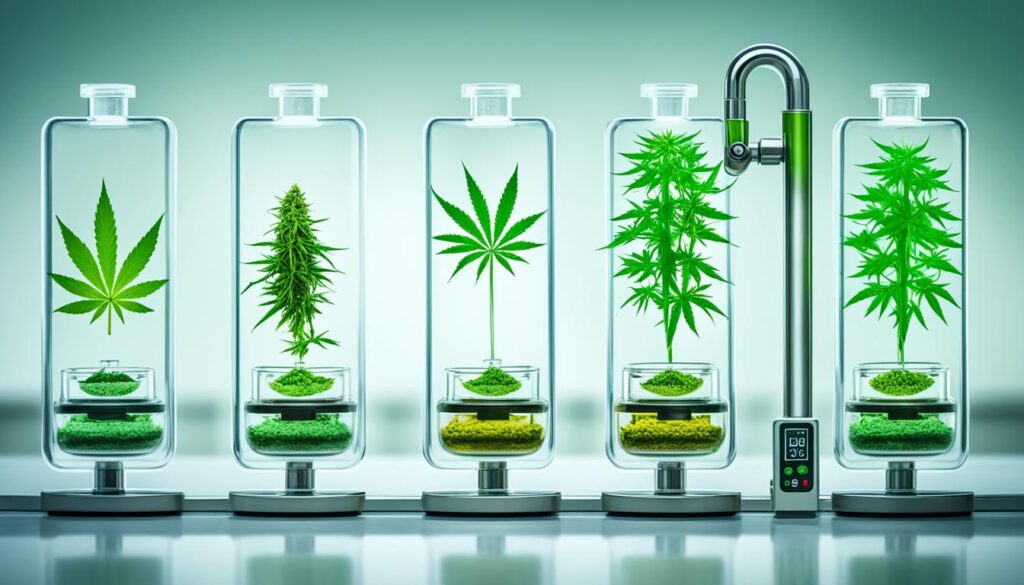
There are many ways to extract CBD, each with pros and cons. Your needs will guide your choice of method.
Remember, the key to the best CBD extraction is evaluating important factors. These include recovery rates, safety, and cost. With the right choice, you’ll create products that satisfy your customers.
What Happens After CBD is Extracted?
After CBD is taken out, it goes through a key step to clean and purify the extract. This step makes sure the CBD product is top-notch, pure, and safe to use.
In this step, stuff you don’t want like chlorophyll, waxes, and other plant bits are taken out. This makes the CBD extract better and stronger. Techniques like winterization, filtration, distillation, and chromatography are used to do this.
Winterization cools down the extracted CBD oil. This separates the good compounds from the bad ones. It gets rid of impurities and makes the extract purer.
“The post-extraction process is crucial in ensuring the final product meets industry standards and is safe for consumption.”
Filtration is important too. It means pushing the CBD oil through filters to catch any leftovers, making the extract even cleaner.
Distillation helps take out impurities and separates compounds in the CBD extract. The extract is heated up, turns into vapor, and then cools back into liquid. This leaves a purer product.
Chromatography is advanced and separates compounds in the CBD extract. It uses special materials to pick out certain cannabinoids and good compounds. This leads to a very refined and concentrated extract.
The post-extraction process is key to making sure the CBD extract is top quality and ready for CBD products.
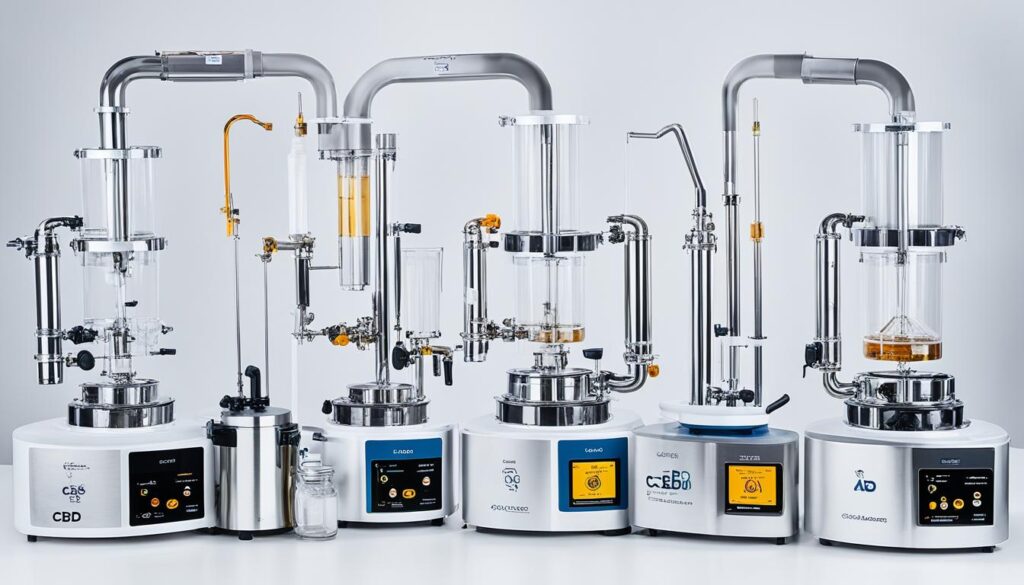
Through the post-extraction steps, CBD extract gets cleaned and purified. It gets rid of bad compounds and improves quality. Techniques like winterization, filtration, distillation, and chromatography help make a pure, high-quality CBD extract.
Types of CBD Extract
There are many types of CBD extract you can find. Each one has special traits and uses. Let’s explore the different kinds:
1. Full Spectrum CBD Extract
Full spectrum CBD comes with everything hemp has, like cannabinoids, terpenes, and flavonoids. It offers a full CBD experience because it combines many compounds. It’s known to boost CBD’s health effects.
2. Broad Spectrum CBD Extract
Broad spectrum CBD is much like full spectrum but has no THC. THC is what makes you feel high. This extract keeps many cannabinoids and terpenes. So, it offers benefits without THC’s effects.
3. CBD Isolate
CBD isolate is the most pure form of CBD. It’s made by removing everything but CBD. This means it has no THC or other elements. It’s perfect for those who only want CBD’s impact.
Choosing the right CBD extract is based on what you prefer and need. Full spectrum has all natural parts, broad spectrum has no THC, and isolate is pure CBD.

Why Should You Care About CBD Extraction Methods?
Understanding CBD extraction is key for those who value product safety and quality. Different methods lead to diverse purity levels. This affects how well beneficial compounds are kept, impacting the product’s overall quality.
By knowing about CBD extraction, buyers can make smarter choices. They think about things like organic certification, safety, and cost. This knowledge helps people choose CBD products that fit what they want and need.
Knowing about CBD extraction also sheds light on how complex making high-quality CBD is. It shows the hard work and know-how needed to make top-notch products. This helps us appreciate the effort behind CBD extraction even more.
In summary, caring about CBD extraction methods helps consumers choose wisely. It allows them to focus on safety, quality, and their own likes, leading to a better CBD experience. By understanding these methods, people help push the CBD industry forward.